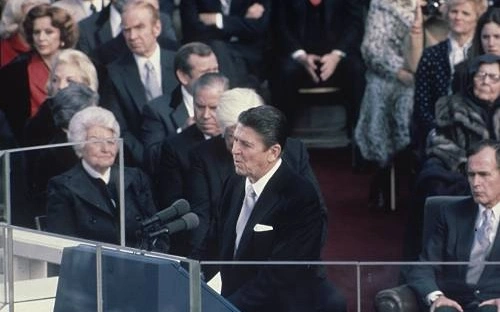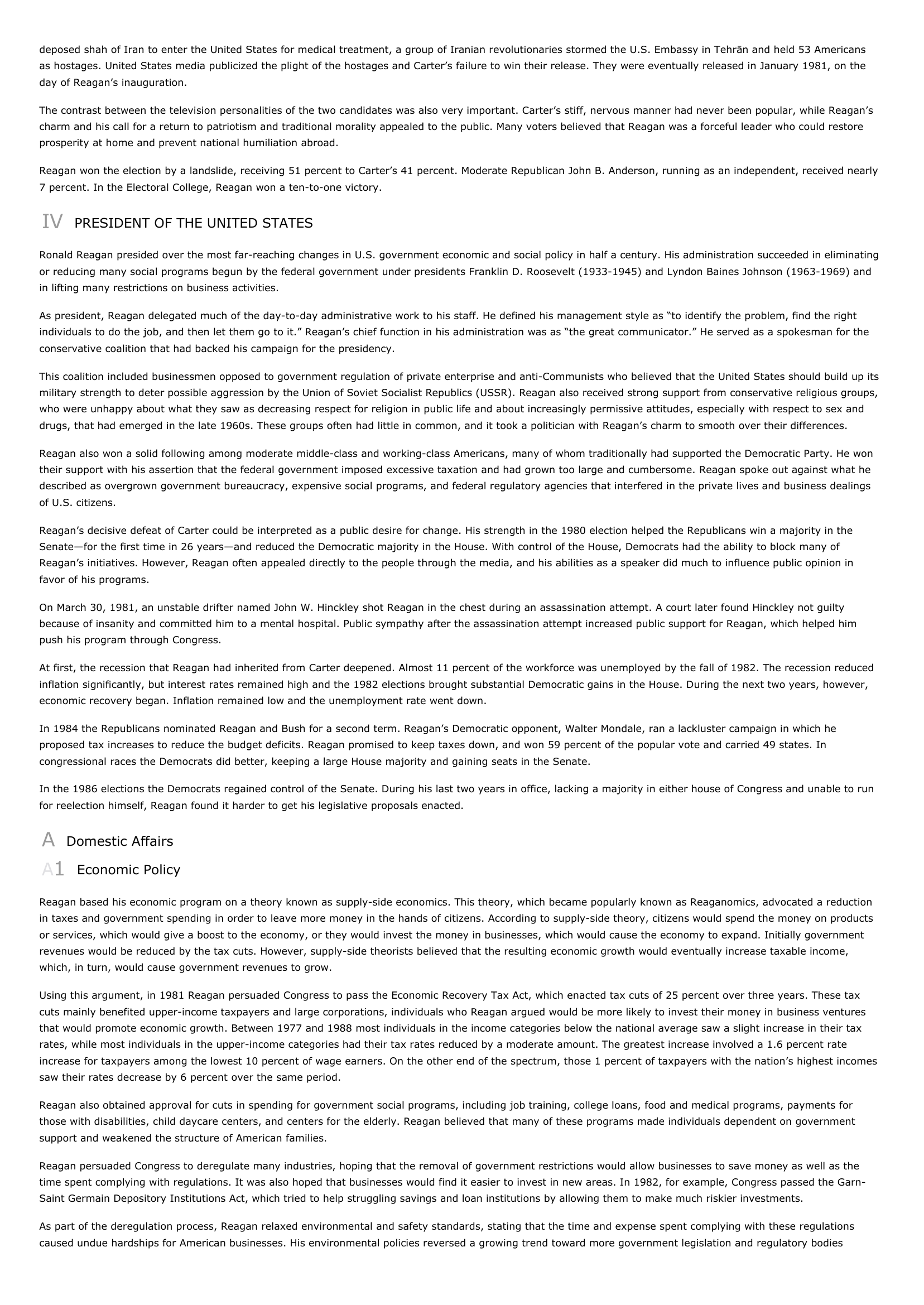Ronald Reagan - USA History.
Publié le 02/05/2013

Extrait du document


«
deposed shah of Iran to enter the United States for medical treatment, a group of Iranian revolutionaries stormed the U.S.
Embassy in Tehrān and held 53 Americansas hostages.
United States media publicized the plight of the hostages and Carter’s failure to win their release.
They were eventually released in January 1981, on theday of Reagan’s inauguration.
The contrast between the television personalities of the two candidates was also very important.
Carter’s stiff, nervous manner had never been popular, while Reagan’scharm and his call for a return to patriotism and traditional morality appealed to the public.
Many voters believed that Reagan was a forceful leader who could restoreprosperity at home and prevent national humiliation abroad.
Reagan won the election by a landslide, receiving 51 percent to Carter’s 41 percent.
Moderate Republican John B.
Anderson, running as an independent, received nearly7 percent.
In the Electoral College, Reagan won a ten-to-one victory.
IV PRESIDENT OF THE UNITED STATES
Ronald Reagan presided over the most far-reaching changes in U.S.
government economic and social policy in half a century.
His administration succeeded in eliminatingor reducing many social programs begun by the federal government under presidents Franklin D.
Roosevelt (1933-1945) and Lyndon Baines Johnson (1963-1969) andin lifting many restrictions on business activities.
As president, Reagan delegated much of the day-to-day administrative work to his staff.
He defined his management style as “to identify the problem, find the rightindividuals to do the job, and then let them go to it.” Reagan’s chief function in his administration was as “the great communicator.” He served as a spokesman for theconservative coalition that had backed his campaign for the presidency.
This coalition included businessmen opposed to government regulation of private enterprise and anti-Communists who believed that the United States should build up itsmilitary strength to deter possible aggression by the Union of Soviet Socialist Republics (USSR).
Reagan also received strong support from conservative religious groups,who were unhappy about what they saw as decreasing respect for religion in public life and about increasingly permissive attitudes, especially with respect to sex anddrugs, that had emerged in the late 1960s.
These groups often had little in common, and it took a politician with Reagan’s charm to smooth over their differences.
Reagan also won a solid following among moderate middle-class and working-class Americans, many of whom traditionally had supported the Democratic Party.
He wontheir support with his assertion that the federal government imposed excessive taxation and had grown too large and cumbersome.
Reagan spoke out against what hedescribed as overgrown government bureaucracy, expensive social programs, and federal regulatory agencies that interfered in the private lives and business dealingsof U.S.
citizens.
Reagan’s decisive defeat of Carter could be interpreted as a public desire for change.
His strength in the 1980 election helped the Republicans win a majority in theSenate—for the first time in 26 years—and reduced the Democratic majority in the House.
With control of the House, Democrats had the ability to block many ofReagan’s initiatives.
However, Reagan often appealed directly to the people through the media, and his abilities as a speaker did much to influence public opinion infavor of his programs.
On March 30, 1981, an unstable drifter named John W.
Hinckley shot Reagan in the chest during an assassination attempt.
A court later found Hinckley not guiltybecause of insanity and committed him to a mental hospital.
Public sympathy after the assassination attempt increased public support for Reagan, which helped himpush his program through Congress.
At first, the recession that Reagan had inherited from Carter deepened.
Almost 11 percent of the workforce was unemployed by the fall of 1982.
The recession reducedinflation significantly, but interest rates remained high and the 1982 elections brought substantial Democratic gains in the House.
During the next two years, however,economic recovery began.
Inflation remained low and the unemployment rate went down.
In 1984 the Republicans nominated Reagan and Bush for a second term.
Reagan’s Democratic opponent, Walter Mondale, ran a lackluster campaign in which heproposed tax increases to reduce the budget deficits.
Reagan promised to keep taxes down, and won 59 percent of the popular vote and carried 49 states.
Incongressional races the Democrats did better, keeping a large House majority and gaining seats in the Senate.
In the 1986 elections the Democrats regained control of the Senate.
During his last two years in office, lacking a majority in either house of Congress and unable to runfor reelection himself, Reagan found it harder to get his legislative proposals enacted.
A Domestic Affairs
A1 Economic Policy
Reagan based his economic program on a theory known as supply-side economics.
This theory, which became popularly known as Reaganomics, advocated a reductionin taxes and government spending in order to leave more money in the hands of citizens.
According to supply-side theory, citizens would spend the money on productsor services, which would give a boost to the economy, or they would invest the money in businesses, which would cause the economy to expand.
Initially governmentrevenues would be reduced by the tax cuts.
However, supply-side theorists believed that the resulting economic growth would eventually increase taxable income,which, in turn, would cause government revenues to grow.
Using this argument, in 1981 Reagan persuaded Congress to pass the Economic Recovery Tax Act, which enacted tax cuts of 25 percent over three years.
These taxcuts mainly benefited upper-income taxpayers and large corporations, individuals who Reagan argued would be more likely to invest their money in business venturesthat would promote economic growth.
Between 1977 and 1988 most individuals in the income categories below the national average saw a slight increase in their taxrates, while most individuals in the upper-income categories had their tax rates reduced by a moderate amount.
The greatest increase involved a 1.6 percent rateincrease for taxpayers among the lowest 10 percent of wage earners.
On the other end of the spectrum, those 1 percent of taxpayers with the nation’s highest incomessaw their rates decrease by 6 percent over the same period.
Reagan also obtained approval for cuts in spending for government social programs, including job training, college loans, food and medical programs, payments forthose with disabilities, child daycare centers, and centers for the elderly.
Reagan believed that many of these programs made individuals dependent on governmentsupport and weakened the structure of American families.
Reagan persuaded Congress to deregulate many industries, hoping that the removal of government restrictions would allow businesses to save money as well as thetime spent complying with regulations.
It was also hoped that businesses would find it easier to invest in new areas.
In 1982, for example, Congress passed the Garn-Saint Germain Depository Institutions Act, which tried to help struggling savings and loan institutions by allowing them to make much riskier investments.
As part of the deregulation process, Reagan relaxed environmental and safety standards, stating that the time and expense spent complying with these regulationscaused undue hardships for American businesses.
His environmental policies reversed a growing trend toward more government legislation and regulatory bodies.
»
↓↓↓ APERÇU DU DOCUMENT ↓↓↓
Liens utiles
- Reagan Ronald Wilson, né en 1911 à Tampico (Illinois), homme d'État américain.
- Synthese de l'histoire des EU ("A brief History of the USA Michael Moore's movie)
- Ronald Wilson Reagan - biography.
- Ronald Reagan.
- Ronald Reagan : biographie et politique




